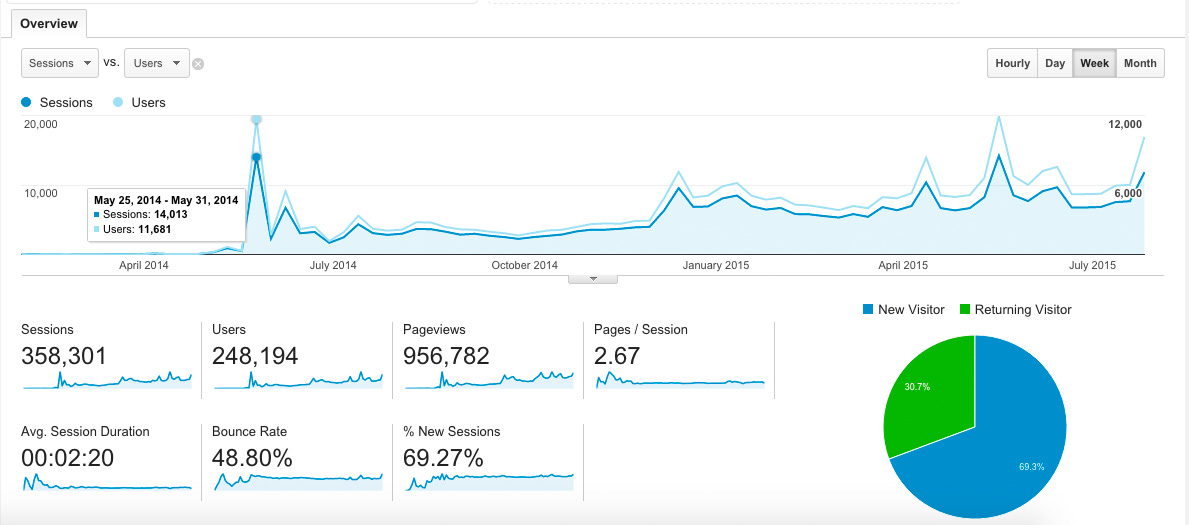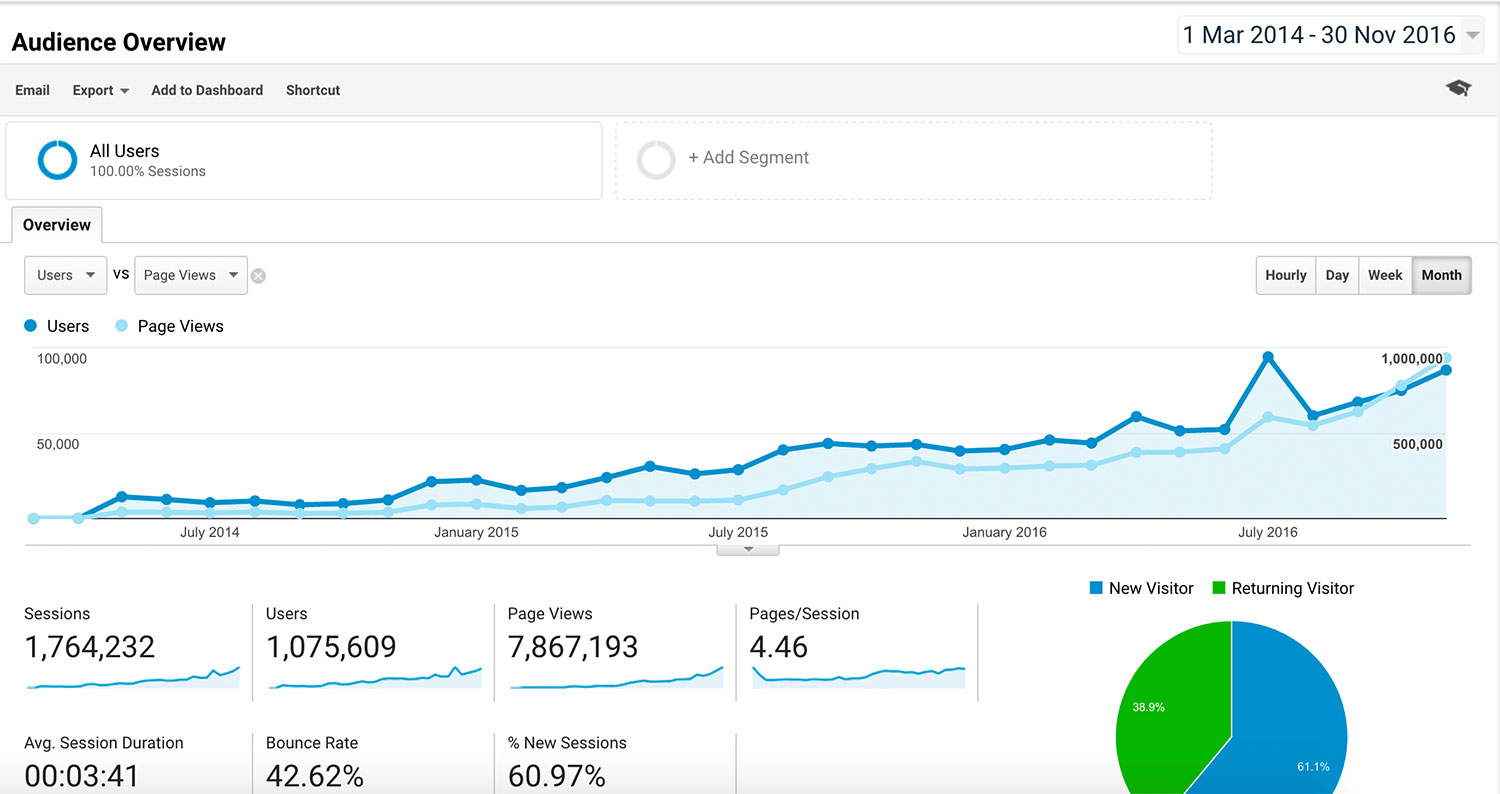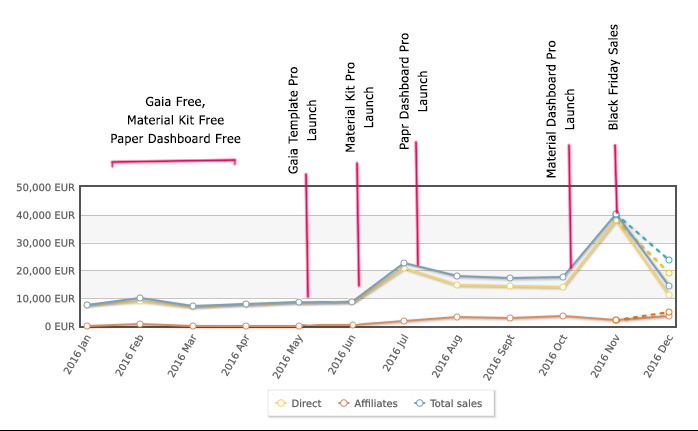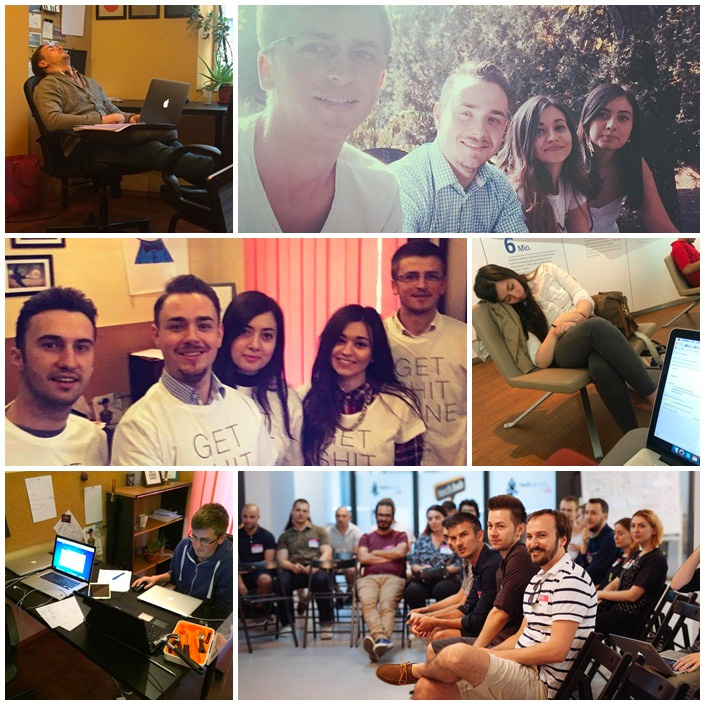Using a Freemium Business Model to Grow Revenue to $17,000/mo
Hello! Tell us about yourself and what you're working on.
I'm Alex Paduraru, I've studied mathematics and computer science, I have a software engineering degree, and I'm the co-founder of Creative Tim. I began working on our startup in partnership with my colleague Cristina Conacel in a Starbucks in Romania.
Creative Tim is a startup determined to build the best possible web design tools. That ranges from UI kits to dashboards, templates, and plugins. We're a team of 6 people and, since our beginning 2 years ago, we've always tried to build products that are helpful in the development process and that we would use ourselves.
At this moment, our products are used by over 130,000 web developers around the world, and we've sponsored more than 20 global hackathons from 14 countries. On the revenue side of things, if we don't take into consideration the Black Friday Sales (which doubled the amount that we made in November), we are doing around $17,000/month.
What motivated you to get started with Creative Tim? And how'd you find the time and funding to build the initial product?
We started in a Starbucks with no outside funding. We didn't have any cash to rent an office or to stay in a hub, so we had to work for different clients in order to make some money to pay for our daily expenses.
Creative Tim was a side project that we thought would come in handy to web developers such as ourselves. We noticed that we were always "reinventing the wheel" in our work with clients by creating the same items for their websites over and over, so we wanted to create some standard elements like login/register modals, calendars, wizards, etc.
For a few months we dedicated time to implementing the platform and a few freebies (alongside the agency work we were doing to support ourselves). In the beginning, because we didn't have any Twitter followers, Facebook fans, or subscribers, we posted a lot of stuff about our freebies on various design forums.
Can you talk more about making these posts? How'd you launch Creative Tim and get your first users?
At first, nobody really understood what we wanted to do, nor the value we provided in order to improve their businesses. It was very hard, so we thought that it would be better to create a more complex product that would help people understand what we were doing.
We launched the Get Shit Done Kit, a UI Kit based on Bootstrap 3. It appeared on Designer News, and it was very popular for that period of time. We got over 11,000 users from that source, which was a huge spike for our business. Then two weeks later we submitted it Product Hunt. That gave us another spike with over 5,000 users. After that the situation was stable, and we switched from 0 users/week to 2-3,000 constant users/week.

A couple of months later, motivated by the success of free Get Shit Done Kit, we released Get Shit Done Kit PRO. We only made a few sales initially — it was generating ~$200/week, not enough to sustain a business. At the same time we were working on a project for one of our big clients.
Then in December we appeared on Bootstrap Expo, the most important gallery that highlights websites created with Bootstrap. This was another important spike for our business, because all the people who go to Boostrap Expo for inspiration already know or had worked with Bootstrap, so these guys were the perfect audience for our business.
What marketing strategies have you used to grow since then?
Most of our marketing strategies have been submitting our content to different communities like Reddit, Product Hunt, Designer News, Hacker News, etc. (Some important subreddits that work well in our area include /r/web_design, /r/html5, /r/frontend, and /r/webdev.)
We've also paid between $100-200 for newsletter campaigns a couple of times. The campaigns were not so good, and the ROI matched the amount that we invested. (Maybe it was just our case that wasn't profitable and it works better for others.) Then we paid $400 for Get Shit Done Kit PRO to appear in the Sidebar.io newsletter, a curated list of the 5 best design links made by Sacha Greif. This was a very rewarding newsletter for us, generating about $1,500 in sales. Then we purchased the "Review + Newsletter" package ($550) from eWebDesign. There were about 5,000 users who participated in the giveaway, and the total sales amounted to $2,800.
We also thought about different places where we can find web developers who could use our products, and we realized that hackathons are exactly what we need. So we started talking to people that are organizing hackathons to offer them free licenses for our "premium products". We sponsored 20 hackathons from different cities around the world (you can check them here). All the developers were happy to get free licenses, which made us happy that we could help them create faster/better projects during the hackathon, and they also found out who we are, so win-win.

How does your business model work? What's the story behind your revenue?
We realized that the best business model for Creative Tim is freemium: to create good looking freebies that help web developers create great websites, then release the PRO versions for those freebies which contain more elements. At this moment we have 8 premium products which have their own freebies, and prices range from $19 to $599 depending on the license and archive type. The freebies appear everywhere on different communities, blog posts, newsletters, social websites, and they are driving all of our traffic.
The basic idea is that those freebies are always appearing on top 10 lists in those big communities. Each post that's in the top 10 (depending on how big is the community) gives you between 1,000 and 15,000 targeted users in one day :-O. I bet you know how much that would cost if you wanted to do a regular marketing campaign...
Some examples:
- Paper Kit — 380 upvotes on Reddit
- Material Kit — 560 upvotes on Reddit
- Light Bootstrap Dashboard Angular — 210 upvotes on Reddit
- Material Kit — 180 uvpotes on Hacker News (peak position 9 with over 14,000 users coming to our website in 1 day)
- Material Kit — 860 upvotes on Product Hunt
- Get Shit Done Kit — 440 upvotes on Product Hunt
- etc... you've got the idea
Today our revenue comes from a few sources:
Product Sales
Here are the regular sales that are done on our website, they are about 24% of the overall sales. This doesn't include the Big Bundle.
What the heck is this Big Bundle? We've seen that some of our users are downloading all our free products. (When I say all, I literally mean all of them in about 2-3 minutes after they create an account.) We've also seen that some of our clients are purchasing all the products that are premium.
So we decided to test a new product called "Big Bundle" which gives you access to all our products with huge discounts (over 60%). This big package is getting around 6-8 purchases per month. Since the prices for this Big Bundle are $299 (instead of $500) for the personal license and $669 (instead of $2,127) for the developer license, it's a good source of revenue and a great deal for the web designers/agencies who are using our products for multiple clients, win-win.
Affiliate Sales
We're also growing an affiliate network, and our affiliates are very happy because they get 50% of each transaction. For example, one of our most important affiliations is done through a very popular GitHub Repo: Bootstrap Material Design (17,000+ stars on GitHub). You can see that our friend Federico has two banners with our products. At this moment affiliates account for around 25% of our overall revenue.
Organic Search (SEO)
We've seen that we are also getting some revenue from SEO, that is around 22% of the revenue. So we decided to invest in SEO and we've got an SEO consultant which we pay around $500/month to improve our products ranks in Google.
Other
The remaining part of our monthly revenue comes from Facebook, Twitter, and our newsletter. Here's how our revenue has evolved over time, along with some historically important moments so you can understand why it's grown in some months:

As for how we burn cash, 44.5% of our revenue is profit, 42% goes to salaries, 7.5% pays for our office, 3% covers server costs, and the remaining 3% covers unexpected expenses.
What are your goals for the future? Are there any big challenges you see on the horizon?
By working on all these changes and products we found that we really love what we do, and so we will continue to grow Creative Tim. Our products are now more mature than the ones we created last year. We've seen people from Microsoft, Vodafone, Orange, Ubisoft, Harvard University, Stanford University, and government downloading and using them in different internal tools.
So this is not a side project anymore, it's a real business and we must deliver things at high quality, no matter how many products we create or how many people are in the team. We want to increase the overall quality, documentation, and have more updates cycles on the actual products. Knowing that our business has become profitable, we now want to invest all the profit in the development of new products, the growth of our team, and the development of a new platform called DaaS.
DaaS (Design as a Service): I don't know if this term exists or if it's even correct (view more about SaaS, IaaS, PaaS). But it's cool, and we want to use it for the current project that we are working on. We've seen a problem on the templates/dashboards market: When you buy a template/dashboard/UI kit, you buy a big package with a lot of libraries that you probably don't need (probably everybody is using only 10% of what he is purchasing, but each person is using a different 10% so you cannot reduce that to a simple/minimal product). So we are building a web app where you will be able to choose the design that you want for your project and the features that you want to include (like data tables, jQuery validation, wizards, vector maps, Google Maps, cards, sliders, switches, etc), then we will deliver that package to you.
New Products: We are working on the development of new UI kits and dashboards. Recently, we've talked with the guys from InvisionApp to convert one of their most popular UI kits made with Sketch into a fully responsive UI kit based on Bootstrap. Unfortunately, we cannot share which product or give you more details at this moment :-( But stay tuned! It will come at the beginning of 2017.
New Affiliates: At this moment we are giving 50% of each transaction that comes from an affiliate. If you want to join us, you can send us the details.
What are the biggest lessons you've learned so far? If you had to start over, what would you do differently?
Don't look to be the next Facebook, try to solve a real problem instead. Every step in our development seemed like the natural thing to do at the time. Looking back at our evolution, we wouldn't change anything. But we would definitely be able to do it faster this time around. We've always created and improved our products based on the customers' feedback and that is the best way to develop a business. It doesn't matter what you like, you need to make sure you solve a real problem for a real customer.
If you want to go fast go alone, if you want to go far go together. I've couldn't have done anything from this story without my special colleagues. I'm blessed to have such great and young people around me. Here is a collage with us "working hard":

Read, read, read. In the last 2 years I've read more than I've read in my entire life, and this makes me feel great. Here are some of my favorite books that I recommend to everybody:
- How to Win Friends and Influence People – Dale Carnegie
- Zero to One – Peter Thiel
- The Hard Thing About Hard Things – Ben Horowitz
- Law of Success – Napoleon Hill
- Think and Grow Rich – Napoleon Hill
- Good to Great – Jim Collins
- The Lean Startup – Eric Ries
- The Charisma Myth – Olivia Fox Cabane
- Lean Analytics: Use Data to Build a Better Startup Faster – Alistair Croll
What's been most helpful to you on your journey? And what's your advice for aspiring indie hackers?
I think the best decision that we've made was to put our customer in the first row and make sure that he is receiving a great UI kit/dashboard that was solving his problem. That guided us through the whole journey. I really do think that our secret weapon is that we deliver great products combined with a great user experience and great customer support.
My advice is that everything is possible. We are living in a world where anybody can become anything they want as long as they want to invest the amount of time that is needed. I'm saying time, and not money, because we all have time. I want to recommend 2 books that are talking about this: Karaoke Capitalism - Jonas Ridderstråle, Kjell Nordstrom and Zero to One - Peter Thiel (Paypal co-founder).
At this moment, there are no limits: You can go anywhere on the planet, you can talk with whom you want just by contacting them on their social profile, etc. For example, a regular person, can have a bigger influence than the president of a small country. Think of those Instagram accounts with millions of followers. If me (a regular guy from Romania) built in 2.5 years a profitable business that is making 60x MMW (minimum monthly wage), then boy, everything is possible.
Where can we go to learn more?
- Official Website: http://www.creative-tim.com
- Our Blog: http://blog.creative-tim.com
- Email: [email protected]
- Facebook: https://www.facebook.com/axelut
- Twitter: https://twitter.com/axelut
- You can read my detailed blog posts about how we started our business with $0 and every step in detail here and here.
Hope this motivates you to start your own business. Just drop me a message if you have any questions — I would be glad to help you!
